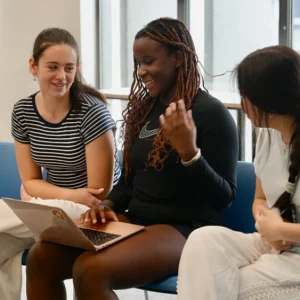Active listening skills are essential for effective communication, requiring complete attention, comprehension, and a thoughtful response. Active listeners hear what is being said and engage with the message, ensuring deeper understanding and improved interaction.
By improving your ability to listen actively, you create meaningful connections, foster mutual understanding, and enhance your capacity to absorb and apply knowledge effectively. The following sections will define active listening and provide practical techniques to develop and refine this indispensable skill.
What are Active Listening Skills?
Active listening skills involve more than just hearing words; they require engaging with the thoughts, emotions, and intent behind the message. Harvard Business School scholars Robin Abrahams and Boris Groysberg identify three critical dimensions:
- Cognitive: Focusing on the explicit and implicit messages in what is being said, processing and synthesising the information.
- Emotional: Remaining calm and empathetic, managing personal reactions to ensure open communication.
- Behavioural: Demonstrating attentiveness and understanding through verbal affirmations, body language, and reflective responses.

Active listening transforms conversations into collaborative exchanges. It requires attentiveness, thoughtful reflection, and the retention of shared information, thereby ensuring a meaningful dialogue for both speaker and listener.
10 Practices for Better Active Listening Skills
Mastering active listening requires the application of various techniques that can help ensure full engagement and understanding during conversations. Here are 10 powerful practices to enhance your active listening skills.
1. Be Fully Present
Being fully present means putting away distractions, such as mobile phones or other devices, and focusing all your attention on the speaker. By maintaining eye contact and tuning into the speaker’s tone of voice, body language, and non-verbal cues, you can better understand both their message and emotions.

Fully engaging with someone involves immersing yourself in their perspective, putting aside your own thoughts and distractions, and focusing entirely on understanding their message.
2. Use Positive Body Language
Nonverbal cues, including facial expressions, posture, and gestures, contribute significantly to active listening. Leaning slightly forward, nodding, or smiling can signal engagement and empathy.

Similarly, maintaining an open posture fosters trust and shows you are attentive. In virtual settings, maintain eye contact by looking at the camera and avoid multitasking to communicate genuine involvement.
3. Avoid Interrupting or Judging
Interrupting or prematurely judging a speaker can create barriers to effective communication. Ensure the speaker finishes their thoughts before you respond. Interruption may cause misunderstandings and lead to a lack of respect for the speaker’s perspective.

In addition, avoid rushing to judgment, as this can make the speaker feel unsupported or invalidated. Instead, offer empathy and refrain from interjecting until they have finished expressing their point.
4. Paraphrase to Reflect
Paraphrasing, or restating what the speaker has said in your own words, is an essential technique for ensuring understanding. It clarifies the message and signals to the speaker that you are genuinely engaged.

For example, you could say, “So, what I hear you saying is…” or “It sounds like you’re feeling…” This approach helps reduce misunderstandings and allows the speaker to clarify their thoughts.
Additionally, paraphrasing enables you to demonstrate your active listening and empathy.
5. Ask Open-Ended Questions
Open-ended questions deepen the conversation and provide further insights into the speaker’s perspective. Instead of asking “yes/no” questions, you can encourage more in-depth responses with these questions:
- “What led you to this decision?”
- “Can you elaborate on how this impacts you?”
- “How can I support you in this?”

Avoid leading or judgemental questions that may close off avenues of communication. Instead, focus on queries that promote exploration and understanding.
6. Validate Speaker’s Perspective and Emotions
Validation is a critical component of active listening, as it helps the speaker feel understood and respected. Even if you disagree with their perspective, acknowledging their emotions or viewpoints creates a sense of empathy and fosters a safe environment for open communication.

For example, phrases such as “I can see why you might feel that way” or “It sounds like that was really frustrating for you” can make the speaker feel heard and valued.
7. Summarise Action Items
At key points in the conversation, especially towards the end, summarising the main points and action items can help clarify mutual understanding and the next steps. Summarisation ensures that both parties are on the same page and provides an opportunity for clarification if necessary.

For instance, after discussing a project, you might say, “Just to confirm, we agreed that I will send you the report by Friday, and you’ll review it over the weekend. Is that correct?”. Summarising reinforces the key ideas and encourages a sense of responsibility.
8. Withhold Advice Unless Asked
One of the most common pitfalls in active listening is offering unsolicited advice. While your intention may be to help, it’s important first to ensure that the speaker is seeking guidance.

Offering advice too early can come across as dismissive of their feelings or thoughts. Instead, focus on listening and supporting the speaker’s process.
9. Keep Good Eye Contact
Eye contact communicates attentiveness and respect, signaling that you are present in the conversation. However, be mindful not to overdo it, as excessive eye contact can feel intimidating or unnatural.

Follow the “50/70 rule” – maintain eye contact for about 50% to 70% of the time to ensure a comfortable connection with the speaker.
10. Be Patient
Allow the speaker to take their time, and resist the urge to interrupt or complete their sentences. Being patient demonstrates respect for their thoughts and gives them space to express themselves fully.

Silence can also be powerful in active listening; giving the speaker a moment to gather their thoughts can lead to deeper reflection and more thoughtful responses.
Build Stronger Active Listening Skills with UNIS Hanoi!
Active listening skills form the cornerstone of meaningful learning and connection. At UNIS Hanoi, we incorporate active listening as a key teaching methodology to nurture effective communicators. Guided by the International Baccalaureate (IB) programme, we empower our learners to articulate their ideas while fostering empathy and mutual understanding through active listening.

Our innovative pedagogical approach emphasises listening as an active, interpretive process that builds bridges of understanding. By enrolling in UNIS Hanoi, you join a community committed to cultivating lifelong learners who excel as compassionate, reflective communicators.
Begin your journey with us today – apply now and experience the transformative power of active listening!
Author Profile

- UNIS Hanoi is ever-evolving, but one thing that remains is our passion to nurture and equip students to be agents of change for a better world.
Latest entries
 Calendar, News and Publications30 Oct 2025What is an IB School? A Complete Guide for Parents
Calendar, News and Publications30 Oct 2025What is an IB School? A Complete Guide for Parents Calendar, News and Publications29 Oct 2025School Tour at UNIS Hanoi – A Comprehensive Guide for Parents
Calendar, News and Publications29 Oct 2025School Tour at UNIS Hanoi – A Comprehensive Guide for Parents Calendar, News and Publications28 Oct 2025How to Choose the Right School for Your Child: The 2025 Guide
Calendar, News and Publications28 Oct 2025How to Choose the Right School for Your Child: The 2025 Guide Calendar, News and Publications27 Oct 2025Student Recruitment at UNIS Hanoi: A Parent’s Comprehensive Guide
Calendar, News and Publications27 Oct 2025Student Recruitment at UNIS Hanoi: A Parent’s Comprehensive Guide
Pingback: Sean O'Brien Death Notice - Sixmilebridge, Co. Clare – Archyde